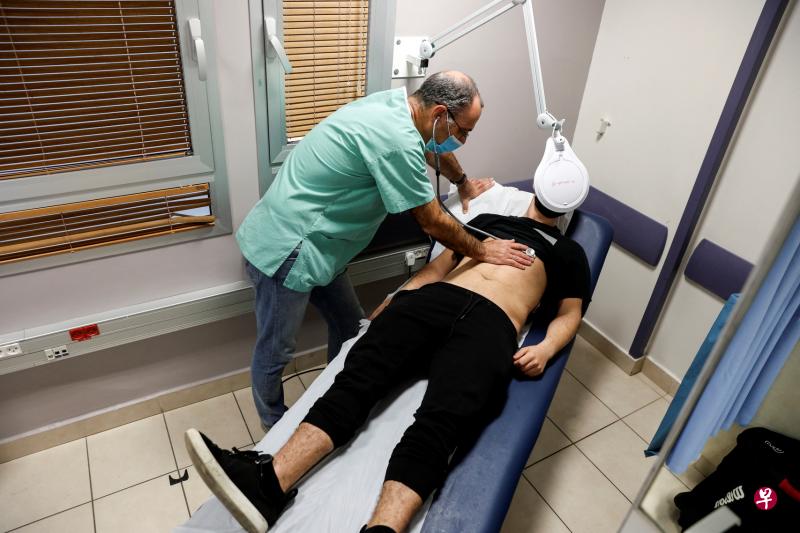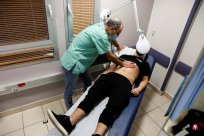
International Special
Li Yanni
For more than years, the prevention restrictions on epidemic prevention in some countries have been completely completely lifted, allowing the lives of the people to gradually return to normal. At the same time, many people who have been infected are still suffering from a series of physiological and psychological sequelae, completely getting rid of the haze of crown disease, and it seems far away. Experts point out that long -term crown disease is a new health crisis in the world, which may cause a heavy burden on society and the economy.At the same time, countries should also invest more resources to study and cope with the long -term impact of this virus.
In April last year, the Canadian Blaikie Hughes was infected with the president of the crown disease for 19 days. When the doctor finally asked her to discharge, she thought she had defeatedVirus, but to this day, she is still influenced by the sequelae of brain mist and fatigue, and even playing with her two daughters is unhappy.
Hugus is a public relationship and communication expertise. After returning to the job, she found that she could not use it as much as in the past. It had only been spent for eight hours.Finish.
She said, "I will stop completely in one sentence, or I can't think of what words to use. This situation has continued to this day." Last August, Hughes was diagnosed with sufferingThere are long -term crown disease, and began to obey the doctor's suggestion for long vacation.
Compared to Hughes, Australian producers and beekeepers, Mirabai Nicholson-McKellar, were very mild.After that, severe sequelae are also occurred.
She said after nearly two years of infection: "I will still feel extremely tired. My sleep, brain cognition and memory have problems. I can't think about it ...The illness completely changed my life. "Because she couldn't work, she couldn't afford the rent and could only live on a car's RV.
Many people, like Hughes, like Nicarson -McLRE, have affected their ability to work due to the sequelae of crown disease.Kathryn Bach, a researcher at the Brookings Society of the US think tank, estimates that about 1.6 million people in the United States have abandoned full -time work due to long -term crown disease, accounting for at least 15%of the nation's vacancy.
A survey by the Patient-Led Research Collaborative Organization also shows that about two-thirds of patients with long-term crown diseases have reduced work hours or fully stopped working.
The United States is the country with the most accumulated infection in the crown disease.There are also many British infected cases. Nearly half of employers have suffered from long -term crown in the past year.
The Chartred Institute of Personnel and Development (CIPD) investigated a totalAmong them, long -term crown disease has become one of the main reasons for employees for a long time.One -fifth of employers said that they do not know if employees suffer from long -term crown disease, which means that the actual scale of this problem may be larger.
At the same time, only 19%of employers provide employees with guidance on how to manage health during work.Rachel SUFF, a senior policy adviser to CIPD employment relationship, said: "Long -term crown disease is still an increasingly serious problem that employers must pay attention to. They should take appropriate measures to support employees with such diseases."
P> Natalie Lambert, an associate professor at the University of Indiana Medical College, pointed out that the most often heard by patients with long -term crown diseases is "you don't look like illness."Because their symptoms may be "invisible", patients often face difficulties when they have not recovered to employers, insurance companies, and even doctors.This has caused them not to get the required sick leave and other support, such as remote office and flexible working hours.In order to keep the rice bowl, some patients can only conceal their condition and barely continue to work.
The cross -party parliamentary group of the British crown disease should be listed as occupational diseases for a long time
The government lists long -term coronary diseases as occupational diseases and provides official guidance for employers.According to the group estimation, the first 18 months of the outbreak of the crown disease epidemic, the British National Health Care System (NHS) employees have accumulated more than 1.82 million sick leave due to long -term crown disease, but the government has about this disease and its key public services to key public services.The huge impact almost turned a blind eye.
In addition to the loss of productivity, ignoring the impact of crown disease and sequelae may also cause legal trouble to employers.The Dutch media reported last week that at least five local people sued the employer for the sequelae after the infection of the workplace.One of them was a emergency nurse. She pointed out that the employer did not fulfill the responsibility of protecting the safety of employees, which caused herself to be infected when she was sent to the hospital.
However, the Dutch Employer Association AWVN believes that the crown disease epidemic has swept the world and cannot blame the employees on employers.FNV, the largest union organization in the Netherlands, pointed out that although such lawsuits often play for a long time, it is important to let employers understand their responsibilities.
Experts predict that there will be more and more legal disputes, but when scientists still have a very limited understanding of long -term crown disease, and different symptoms of patients, it is proved to prove that the plaintiff is due to public infection and a public infection and a public infection.The long -term health problem is a big challenge.
Global scientists are committed to studying long -term crown disease
According to the first official clinical definition released by the World Health Organization last October, long -term crown diseases have affected people who have been diagnosed or may be infected with crown diseaseIt usually occurs three months after infection, and this situation will last at least two months, and it cannot be explained by other diagnosis.At present, scientists around the world are committed to studying this new disease, and their definitions may also change.
Some studies have shown that 10%to 30%of those infected with crown diseases will occur.According to data from the National Bureau of Statistics of the United Kingdom, as of January this year, about 1.3 million people in the UK reported that they had long -term crown, accounting for 2.1%of the national population; 63%of patients said that daily activities were affected, and 18%of their daily activities were "Great limit. "
There are about 200 known sequelae of crown diseases, including fatigue, shortness of breath, sense of smell and taste failure, and cognitive dysfunction.Other symptoms include continuous cough, joint pain, muscle pain, headache, and heart, lung, kidney and intestinal damage.Patients may also face mental health problems such as depression and anxiety.
Long -term crown disease affects all parts of the body, and the symptoms vary from person to person. There is no "one -size -fits -all" treatment plan or universal medicine.A French study released in November last year believes that the so -called long -term crown disease may be more psychological.
However, more and more evidence shows that crown diseases do have visible effects on the human body.A pilot study of 36 patients in the UK found that coronal virus may cause tiny damage to the lungs that cannot be found through conventional testing.This helps to explain why some people still have difficulty breathing after being infected with crown disease.
A study in the United States also found thatAlthough the heart and lungs of long -term coronary patients seem to be normal, when they exercise, the amount of oxygen extracted from the blood from the blood decreases significantly.David M.SYSTROM, a sports physiologist who assisted the study: "This degree of hypoxia cannot be installed."
Another American study released this monthIt shows that after one month of infection, the risk of heart disease, stroke, heart failure, cardiomyitis and pericarditis in patients with crown diseases are higher, even if there is no infection symptoms or mild symptoms.One of the reporters, an epidemic expert Ziyad Al-Aly, said: "The evidence is absolutely clear and convincing."
However, this study was performed before the crown disease vaccine was launched.EssenceThe recent analysis reports of 15 domestic and international research on the UK Health Security Agency (UKHSA) showed that vaccination can significantly reduce the probability of sequelae and can improve long -term crown disease symptoms of those infected before vaccination.
According to a study mentioned in the report, compared to those who have no or unfinished vaccination, two doses of Pfizer, Astraon or Modner vaccine or one dose of Johmnarian vaccineThe risk of the symptoms of long -term championships lasting for more than 28 days has been reduced by half.Researchers pointed out that this highlights the importance of vaccination.
A research report published on the cell cells of scientific journals shows that the risk factors to increase the sequelae of the crown include: patients with high levels of virus ribosrole (RNA) in the early stage of infection, and some antibodies in the body exist in the bodyEpstein-Barr Virus, which has the second diabetes and lurking in the body, is re-activated.
A British study without peer review is classified as a group with high risk of long -term crown diseases, including patients with diabetes and chronic obstructive pulmonary diseases.
Seeing business opportunities from all walks of life to launch treatment supporting facilities
Many scientists are studying the sequelae of the crown disease. Among them, a long -term coronary study launched by the University of Leicester in the United Kingdom will be the patient.Twent 25 years of tracking.Special long -term crown disease clinics have appeared in some countries, but the waiting list is often very long.
Some private health care operators look at business opportunities and launch services for patients with long -term crown disease, but the price is not cheap.For example, the Austrian Park IGLS's weekly treatment price is 3,000 pounds (about S $ 5440). The treatment course includes professional diagnosis, physical therapy, lung function and blood testing, systemic massage, and beeswax "Liver Compress", etc.;Arrigo charges £ 2,500 a day, and the service items include Biodenamic Medicine, acupuncture, Yin Yoga, meditation, etc.
Brendan Delaney, a professor of medical at the Imperial College of London, believes that if such supporting facilities are combined with professional medical care and rehabilitation activities, and patients also have financial ability, it is a choice while vacation.Of course, not everyone can afford such luxury treatment.
Experts are worried that patients are misunderstanding of false information
Draney itself is also a long -term coronary patient.He pointed out that the list of long -term coronary clinics operated by NHS may be up to 10 months, so many patients will find another law to improve their diseases.
However, experts express concerns about patients' misunderstanding of false or unconfirmed information.The websites of the U.S. non -profit tissue "Frontline Crown Cruel Care Alliance" (FLCCC) listed about 20 treatment drugs and therapies for long -term coronary diseases, including the prescription drugs for the treatment of parasitic infections, and IveremectinMaraviroc, steroids, and diuretics.
A number of doctors condemned that the organization's use of these drugs under the lack of scientific evidence to treat long -term crown disease is a very "irresponsible and immoral behavior."
American actress Gwyneth Paltrow also previously shared his experience of defeating the sequelae of the crown and took the opportunity to promote his own products.In February last year, she posted on her own living information website, revealing that she would fast and make infrared sauna, and listed a series of products she used to overcome fatigue and brain fog, including sauna blankets with a price of nearly 400 pounds, 105The pound of water cups and so on.
NHS medical director Stephen Powis pointed out: "Some of her recommendations are not recommended by NHS. We must take long -term crown diseases and apply serious science. All social media use social media.The Internet celebrities are responsible and obligated. "




